If Arthur Rimbaud was the one who freed poetry from text and writing, giving back a magical idea of life through the "wandering" of the "cursed" traveler, where the search created more of an ethics than an aesthetics, then Allen Ginsberg it was he who brought poetry back to its roots, to action, immediacy and "performance", giving flesh and bones to verse through public recitations. The former invented a new system of values, based on subversion, bohemian life and "palehumanism", the latter chose to become a "seer" and a visionary, expanding by all means the field of consciousness, perception and sensations.
Ginsberg was one of the three poles of the basic, triadic core of the beat generation, a distinct literary, cultural and social phenomenon, which was born in the 50s in the United States and wanted to realize the dreams of Rimbaud and Whitman:"give up everything, take the streets". On the occasion of the 96th anniversary of his birth (3/6/1926), the Magazine dedicates today a few lines and thoughts to the "obscene" beatniks, that group who decided "to live from day to day, not caring about tomorrow".
THE EMERGENCE OF THE BEATNICKS IN THE 1940s

They appeared in post-war America, a small group of young people who wished to express themselves through a new, vibrant language and whose relationship with the dominant values of the time was more than problematic. Their influences came directly from the so-called "lost generation". - represented by their elders, Ernest Hemingway, Thomas Woolf and Thomas Eliot - but also by the poets Rimbaud, Whitman and Blake. These young people, pessimistic, anxious, negative and unconventional, could not adapt to the American way of life.
Instead, they discovered that they shared the same sensibilities and preferences and shared the same rebellious spirit. One of them, Jack Kerouac , when he wanted to describe in 1948 his social and artistic environment to the writer John Clelon Holmes, he used the word "beat", which eventually characterized that entire generation. As we wrote above, it was a "phenomenon", but it certainly could not be called either a group, a school, or a movement, terms that were usually used to describe artistic - mainly European - currents.
THE BEAT AND THE WANDERING
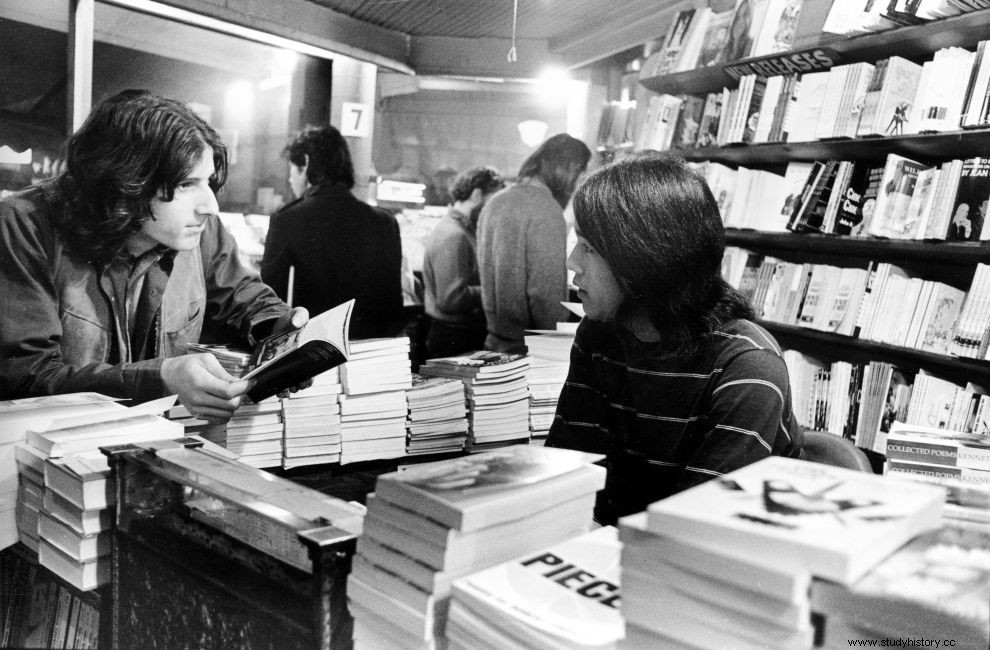
Beatniks were more of a community, bound together by bonds of friendship, love and desire, yet its characteristics were both obvious and ambiguous, just like the definition of beat , which could not be explained in a single way. This word corresponded to three interpretative directions, which at the same time contradicted but also complemented each other. The first, without a doubt the most important, but also the most directly indicative, concerned a behavior:the road, the journey, the wandering. Beatniks stole cars, drank alcohol, smoked weed, gave girls sidelong glances, "squeezed" but eventually got it clean.
The important thing in this "route" was to avoid the townspeople and go to the camp of the rejected, where the Indians, the Blacks, the unshaven vagabonds were "waiting" for them. The beatniks were ready to sabotage the fictional "American dream" of the Eisenhower era, where citizens took care of their car, listened to the preacher's sermon, lived within the conventions. The search for the "stealth passengers" of the beat aimed to initiate in all ways, even the most dangerous, the least "religious", into the state of bliss.
THE BEAT AND THE SELF DESIGNS OF JAZZ

On this way, they encountered Buddhism, Hinduism and Zen, mainly with the arrival in the USA of the master Daisetsu Teitaro Suzuki in 1958, but also in general the oriental traditions, which were interpreted with a new look and idealized, leading to a metaphysical, dreamy "orientalism". The second direction, equally important, was music. Here the beat (rhythm, meter) had to do with the particularity of jazz, but also swing, blues, be-bop and later with free jazz.
The latter was unrelated to other jazz movements or styles, but was a"power" who aspired to free it once and for all from the formal and pretentious enclosure in which it was in danger of being trapped and deliver it - through improvisation - free to where it belonged, that is to risk, danger, joy, explosion, noise and passion. These lively and vital pulses of free jazz were directly related to the concept of freedom sought by beatniks:"free poetry", "free life" , free poetry and life that referred to the search for a musical way of being in language and in the world.
THE BEAT AND THE "LOST GENERATION"

Finally, the third direction was also the most negative. It showed the defeat, the failure, the feeling of the one who had been hurt by the era and History, which also suggested the continuation of the "lost generation":"You have me beat", "you have defeated me", "I surrender". But let's get back to the beat phenomenon. Initially, the beatniks were some young people who received the same social, moral and political pressure. Around them were the tensions of the Cold War and, from the 1950s, the paranoia of McCarthyism . As we have already written, the core was threefold:Kerouac, Ginsberg and Burroughs.
Jack Kerouac (1922-1969), child of French-speaking immigrants from Canada, was the "hero", the one who in 1948 coined the term "beat generation" and wrote the "Bible" of the movement, "On the road " ("On the road"), published in 1957, forever changing the meaning of the word "road". The beat counterculture reintroduced the American myth of the eternal traveler, the wanderer, the sojourner and ultimately the conqueror, through a narrative of transcendent inner search, headed for the ultimate unknown and freedom.
JACK KEROUAC AND "ON THE ROAD"

"I knew that somewhere along the way there were girls, visions, everything. Somewhere along the way, someone would offer me a rare pearl." Kerouac, having first thrashed all the seas, dragged his life and soul to shelters from San Francisco to Rome. Shortly after the merchant marine, after returning to New York, he met Ginsberg and Burroughs in the area of Columbia University, but the decisive event for what would follow was his meeting with the writer Neal Cassady, who later, with the name Dean Moriarty , would become the central hero of "On the road".
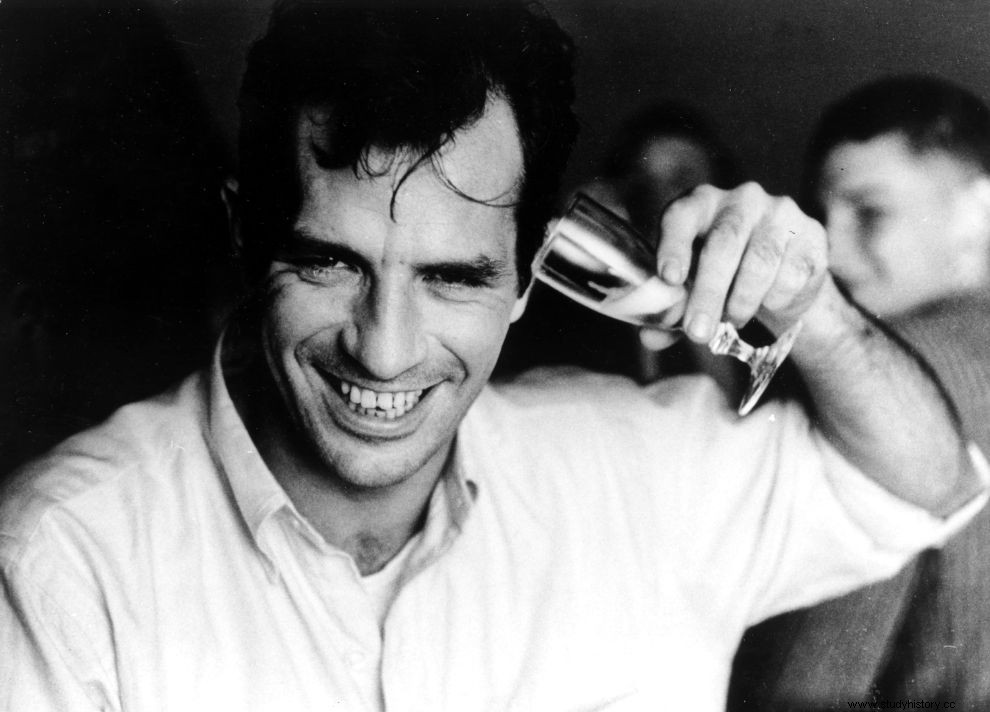
Kerouac's "route" in the book - after the first part, where he describes his 1947 journey to meet Cassady in Denver - was his own difficulty in completing the "road book":failed plans, false starts, fictional deviations. The first question was in what language to"restore" reality and the second, how to handle the narrative, altering as little as possible, a raw material. The "heavenly vagabond" (as Ginsberg described him) wanted to transfer life to text, to phrases that would not just be phrases, to words that would also be actions.

Three years of experiments, tests, desertions and inventions, culminated in three weeks of schizophrenic writing in April 1951, on a single - stapled - roll of paper, so that at no time would the frantic improvisational rhythm on the typewriter be lost, a rhythm that Kerouac called "spontaneous prose", recalling the prophet of improvisation, Charles Mingus , a true master of the game, who ignited fires by going through all the contradictions of jazz, redefining its contours and opening new roads, which were soon followed by others, exactly what "On the road" achieved when it was released in 1957.

The book became an instant success, it was deified, it influenced, it caused explosions whose shock wave reached Europe and even beyond, in every university campus, in every place where alcohol, sex, drugs were worshiped. Kerouac put a life experience at the service of literature, became passionate about the novel adventure and finally discovered what he was looking for:a prose, as much "prose" was being done, to expose reality. All this, he "closed" in a single sentence:"I cannot consider a man free who does not have the desire to break within himself the shackles of language".
ALLEN GINSBERG AND THE "SHOUTING"

The angel-rebel, the beautiful"wild" , without shelter, law and faith, he looked for the place and the way, he closed in a book the tendency of disorderly flight and left himself only at the age of 47, from internal bleeding due to long-term alcohol abuse. More subversive than Jack Kerouac, the other of the trio was presented, Allen Ginsberg (1926-1997), child of a Russian immigrant, Naomi Levi (for whom he wrote his great poem, "Candice") and a teacher and poet , by Lewis Ginsberg.
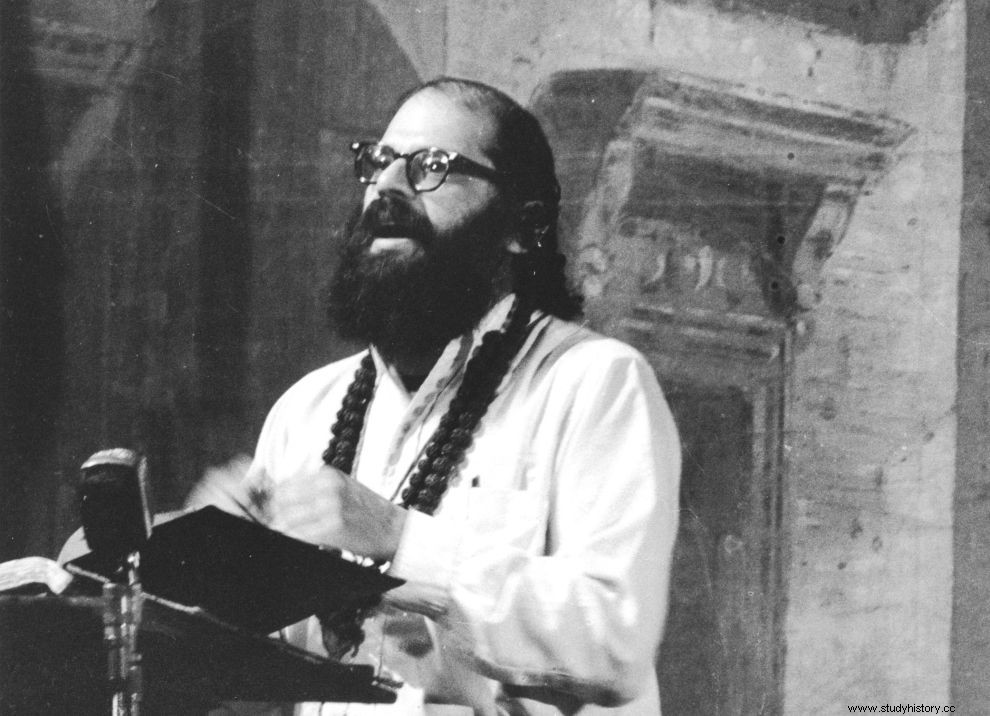
Ginsberg built on a solid foundation his break with the puritanical and conservative America of the 1950s:a communist, a Jew, a homosexual and a poet, since in his opinion the "poet" had to be by definition uncommunicative and judgmental, like the madman and the saint, since, in any case, the tendency towards holiness was part of the poetic design. Wanting to expand the conscious field by any means, he resorted to drugs, in a systematic search for hallucinations. His main role models were William Blake and Rimbaud with "The Seer's Letter" (1871).

In 1956, Ginsberg's poem "Howl" was published, the second "sacred" text of the beat generation, after "On the Road". It was preceded by a public reading of the poem on October 13, 1955 at San Francisco's Art Gallery Six, in the presence of Kerouac and that night had been regarded as one of the seminal acts of birth of the beatnik movement. The poem was dedicated to Carl Solomon, "an intuitive Bronx poet." Also present at the event was the poet, painter and publisher, Lawrence Ferlinghetti, who offered to publish the work directly through his publishing house, City Lights.

"I saw the best minds of my generation disintegrated by madness, hysterically naked and filet, crawling through the negro streets at dawn turning a needed dose." And those "best minds" that Ginsberg so lyrically and expressively described in "Screaming" were drug users , itinerant musicians, dissidents, poets, world travelers. The "doom" of conservative US society was written with wine, marijuana and jazz, according to Gary Snyder, a poet and activist who at the time often visited Ginsberg. The harsh winds, the black despair, the very cries that became poetry, these were the heartbeats of "Howl".
WILLIAM BURROWS AND THE "NUDE MEAL"

The third of the group, William Burroughs (1914-1997) was a completely separate case, after all he himself had "made it clear" in 1969 that he had never joined the beatnik movement, neither in terms of its goals, nor in terms of the literary his style. He had committed a "falsehood" there, talking about "style" , since both Kerouac and Ginsberg did not even have similarities with each other, nor had they ever dealt with such issues, completely indifferent to their own "anarchist" perspective. What is certain is that Burroughs was neither a son of Mother Earth, nor a follower of Zen meditation.
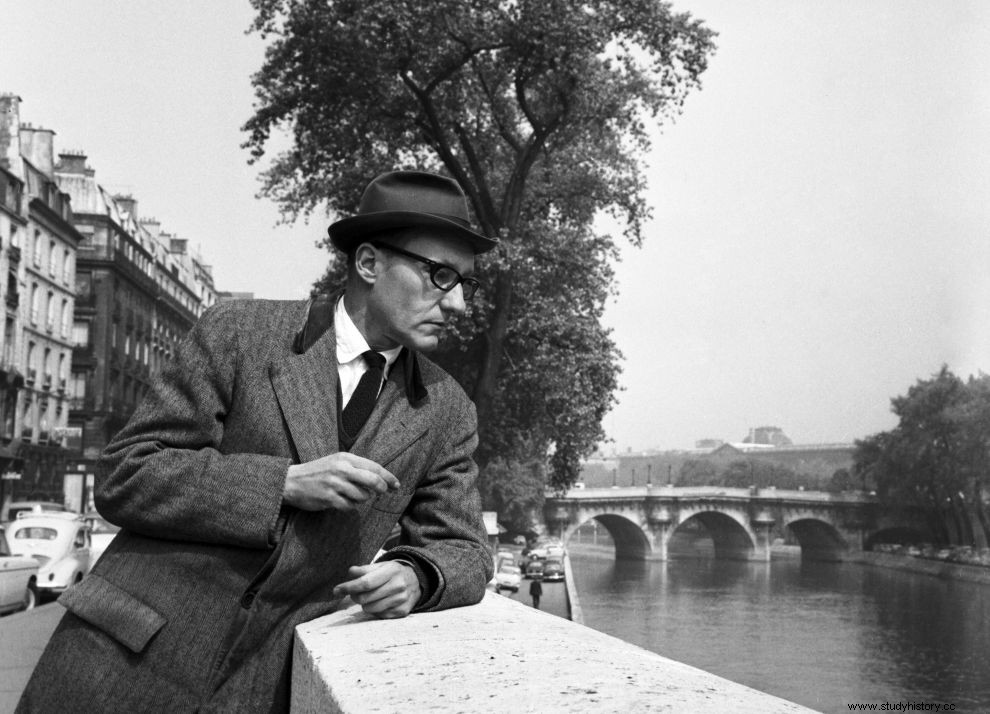
The climate of liberated spirituality did not concern him. He himself was an esthete, in his own eclectic, sophisticated way, an avant-garde rejecter of artistic "orthodoxy", an amoralist, suited to the frosty light of a broken crackling neon sign or the stagnant "wandering" of a constantly masturbating from the opium of conscience, together with theideological guerrilla for the discovery of mechanisms of verbal resistance, such as the famous unconventional cut-up writing.
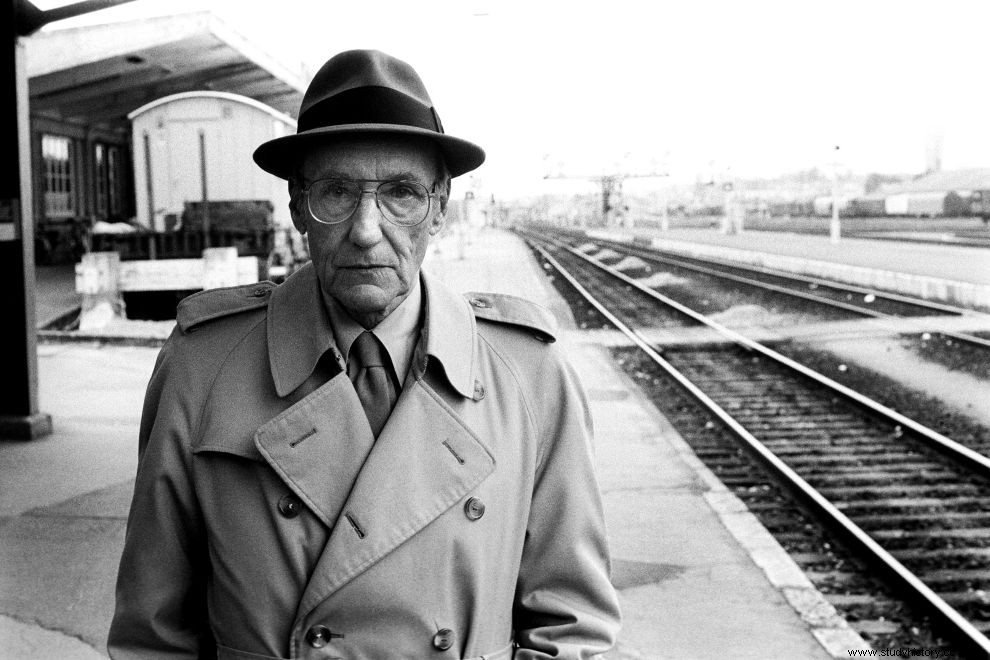
Burroughs he did not deny the friendship adventure of Kerouac and Ginsberg, he himself was one of the fundamental components of the beatnik current of sensibility, but never felt the need to be considered a member of a particular "group". He offered the third "holy" text of the beat generation, "Naked Lunch", released in 1959, perfecting a writing technique that until then had only been known in the Fine Arts. Burroughs himself had said of the cut-up:"Every piece of narrative, or every piece of poetic imagery, in general, is subject to infinite variations, and may all be interesting and valuable in themselves."

"Fragmented writing" was to literature what collage was to painting and montage was to film. As the author characteristically said, "a page of Rimbaud cut-up and rearranged will give you entirely new images. Rimbaud images - real Rimbaud images - but new." The "Naked Meal", which caused intense controversy, even ending up in the courts, was in itself a masterpiece of recording the dark side of human nature, through a "multiple", revolutionary language.
OTHER IMPORTANT MEMBERS OF THE BEAT GENERATION

Beyond the three main "heroes" of the beat, there were many more important figures who participated in the anarchic structure of this phenomenon. First on the list, Neal Cassady, car thief, con man, incarcerated in Colorado, bisexual, tough and direct writer. He wrote only one book, the autobiography "The first third" (1949), influenced Kerouac with the style of his letters, appeared in "On the road" as Dean Moriarty, but also in poems by Ginsberg and completed the "perfect orbit" of 1968, when he was found dead of an overdose on the side of a railroad track in Mexico.

Next is Herbert Hank , writer and poet, a wayward junkie, prostitute in New York and the man who introduced Burroughs to drugs. And he was one of the faces of "On the road" under the name Elmo Hassell, while it is assumed that he first coined the term "beat". His place is occupied by the journalist John Holmes, who in an article in the New York Times, on October 16, 1952, formalized the designation "beat generation", while Lawrence Ferlinghetti, founder of City Light Books, was also very important. of a bookstore and publishing house in San Francisco, established as a hangout for beatniks (as we wrote above, Ginsberg's "Screaming" was published there in 1956).
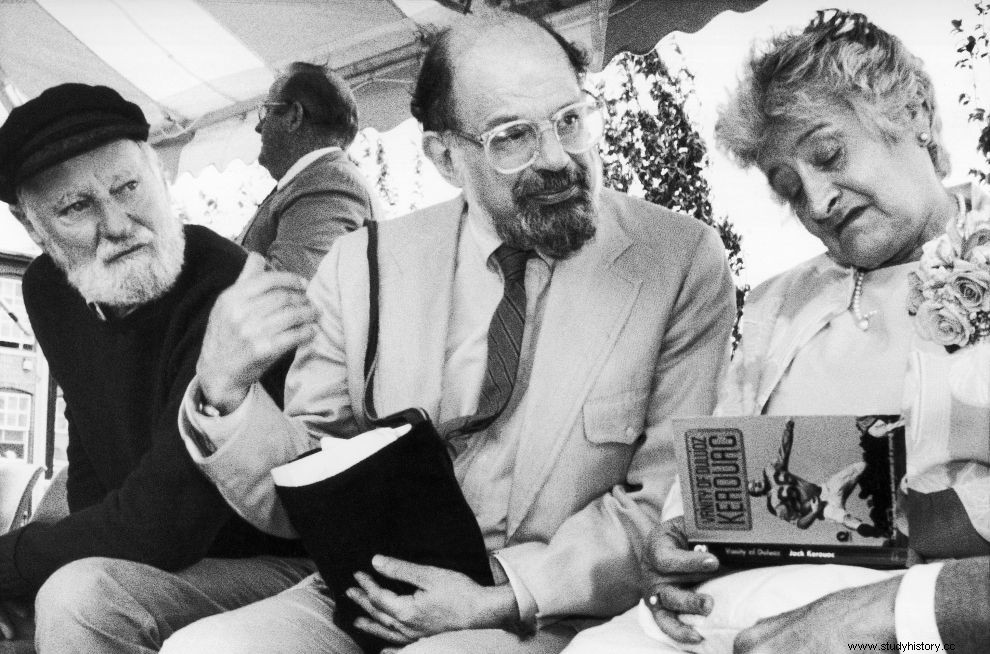
The names on the list are many:poets like Bob Kaufman, Diane Di Prima, Michael McClure, Gary Snyder, and even Bryon Geisin, poet and painter, who invented the cut-up with Burroughs. Of course, Gregory Corso, poet, heroin addict, alcoholic and self-destructive, the youngest of the "hard core" of the beat, with the most important works being "Bomb", a poem written in calligraphic letters that takes the shape of the nuclear "mushroom" ( 1958, published by City Light Books) and "American Elegiac Emotions", a poem dedicated to Kerouac.
BEATNICS, SEX AND DRUGS

Beatniks developed various kinds of relationships with each other, but the sexual relationship was the most defining. Homosexuality and bisexuality, as forms of claiming a new body in love, were included within the general framework of a demand for freedom. In this respect, the ideology of the beat generation paved the way for the sexual liberation movements expressed generally and specifically by the hippies in the 60s and 70s. Το ίδιο ακριβώς συνέβη και με τη χρήση ναρκωτικών μέσα από ένα ευρύ φάσμα εμπειρίας, που οδήγησε σε διαφορετικά αποτελέσματα.
Κάποιοι παραδόθηκαν αυτοκαταστροφικά στην επήρειά τους, κάποιοι άλλοι χρησιμοποίησαν πειραματικά τα παραισθησιογόνα (μεσκάλ, πεγιότλ, LSD κλπ) ως "βοήθημα" σε μια δημιουργική πορεία ή σε αναζητήσεις μυστικιστικής μορφής. Τελικά και εκεί, οι μπίτνικ υπήρξαν "πιονέροι", δίνοντας τη σκυτάλη πρώτα στον γκουρού του LSD, Τίμοθι Λίρι (κολλητό φίλο του Γκίνσμπεργκ) και κατόπιν στα περισσότερα ροκ γκρουπ της δεκαετίας του '60, αλλά και σε εκείνα του '70, σε μια διαρκή προσπάθεια ανακάλυψης "τεχνητών παραδείσων" και αποκάλυψης "αισιόδοξων θαυμάτων".
ΜΠΙΤΝΙΚ ΚΑΙ ΧΙΠΙΣ

Μια δεκαετία μετά το "On the road", οι μπίτνικ είχαν μυήσει τη νεολαία των 60s στην περιπέτεια ενός ριζοσπαστικού ρομαντισμού. Η beat generation είχε "σκληραγωγήσει" τη γενιά των χίπις, την είχε προετοιμάσει με τέτοιο τρόπο, ώστε να απαιτήσει επίμονα ελευθερία σε όλα τα επίπεδα. Η επαναστατική ευαισθησία ήταν μια από τις θεμελιώδεις συνιστώσες εκείνων που ένιωθαν έτοιμοι να αποδομήσουν τα πάντα, πιστοί σε κάθε ανατρεπτική γλώσσα. Το κοινωνικοπολιτικό πλαίσιο στο δεύτερο μισό των 60s προκαλούσε αντιπαραθέσεις πέρα από τα όρια:ο πόλεμος του Βιετνάμ έμπαινε στην κορύφωσή του, ενώ ο Ψυχρός Πόλεμος βρισκόταν στο απόγειό του.
Οι φοιτητές στα Πανεπιστήμια διάβαζαν το "On the road" του Κέρουακ και απάγγελναν μεγαλόφωνα το "America when will we end the human war? Go fuck yourself with your atom bomb" του Γκίνσμπεργκ, ενώ η ψυχεδέλεια είχε ήδη κάνει την εμφάνισή της από τα μέσα της δεκαετίας με τις μπάντες της σκηνής του Σαν Φρανσίσκο και το μουσικό της κίνημα εξαπλωνόταν σε ολόκληρη τη χώρα. Οι χίπις, "καθοδηγημένοι" από τους μπίτνικ, είχαν αρνηθεί την κυρίαρχη αμερικανική κοινωνία της δικής τους γενιάς, ευαισθητοποιήθηκαν με τις θρησκείες της Ανατολής - δυτικοποιημένες από τον Χέρμαν Χέσε - και τάχθηκαν αλληλέγγυοι με τους Ινδιάνους της Αμερικής.

Τελικά όμως διαφοροποιήθηκαν από τις "πατρικές" μορφές των ατομικιστών μπίτνικ, επιλέγοντας τα κοινόβια και τη μαζικότητα, αν και η αφετηρία για την προσωπική τους αναζήτηση ήταν αρχικά ατομική (προφανής κληρονομιά από το beat). Η αφετηρία για την κοινωνική αλλαγή θα έπρεπε να είναι η προσωπική αλλαγή του καθενός:"ο μπάτσος στο δρόμο αποτελεί μικρότερο πρόβλημα από τον μπάτσο που έχουμε μέσα στο μυαλό μας". Οι χίπις, που στην πραγματικότητα υπήρξαν "παιδιά" των μπίτνικ, προτίμησαν έναν πιο φιλειρηνικό δρόμο, πιο ήσυχο, πιο γαλήνιο, σε πλήρη αρμονία με τη Μητέρα Γη, εξ ου και το ινδιάνικο πρότυπο.
Ήταν όμως εκείνοι που πήραν ιδέες των μπίτνικ, όπως η οικολογία, ο γυμνισμός και οι αντιπολεμικές διαμαρτυρίες και τις μετέτρεψαν σε παγκόσμια κινήματα. Και το γεγονός ότι υπήρξαν οπαδοί της συγχώνευσης σε μεγάλες μαζικές συγκεντρώσεις και θιασώτες της "κοινής" ζωής σε συλλογικές και συνεταιριστικές μονάδες , βοήθησε στην εξάπλωση αυτών των κινημάτων, που ξεκίνησαν από το beat, του οποίου όμως τα μέλη λειτούργησαν διαφορετικά, με βάση τον ατομικισμό:ο καθένας μόνος του ή το πολύ, δυό-δυό, τρεις-τρεις, αλλά ποτέ με την ομάδα, με το τσούρμο, με το πλήθος.
Η ΕΚΦΡΑΣΤΙΚΗ ΠΡΟΣΕΓΓΙΣΗ ΤΗΣ "ΑΓΙΑΣ ΤΡΙΑΔΑΣ" ΤΟΥ BEAT

Ας επιστρέψουμε τώρα στην ίδια την ουσία του beat, που δεν ήταν άλλη από τον τρόπο έκφρασης, τη γραφή, τα χαρακτηριστικά εκείνα που προσδιόρισαν τη λογοτεχνική προσέγγιση των μπίτνικ. Και εδώ, θα βρούμε ξανά τους τρεις διαφορετικούς πόλους, τον καθένα ασυμβίβαστο και ξεχωριστό, αλλά με αυτή τη μοναδική ιδιαιτερότητα του beat, όλοι μαζί να αντικρούονται και να αλληλοσυμπληρώνονται. Ξεκινώντας με τον Κέρουακ , μπορούμε να πούμε ότι στο γράψιμό του βρίσκουμε την αναζήτηση του "ρεαλισμού", με την αμεσότητα που προσφέρει ο παλμός της εμπειρίας, είτε στην πεζογραφία (στο "On the road", ο συγγραφέας γράφει αυθόρμητα, χρησιμοποιώντας την καθομιλούμενη), είτε λυρικά και "μουσικά" (όπως στα χορικά του Mexico City Blues).
Ο Γκίνσμπεργκ , το γράψαμε και πιο πάνω, εκπροσωπεί τον λυρικό πόλο, πιστεύοντας στη ριζική αντίθεση ανάμεσα στην κλασική ποίηση και την πραγματική ποίηση. Από τη μια δηλαδή, έχουμε μια τυπική ποίηση που υποτάσσεται στο αφηρημένο μέτρο και τη νεκρή γλώσσα, ενώ από την άλλη έχουμε τη φυσική ποιητική της αναπνοής με τον ρυθμό, σε ζωντανή γλώσσα, που οδηγεί στην ποίηση της δράσης και της "παράστασης". Τέλος, ο Μπάροουζ εκφράζει έναν κριτικό, επιθετικό ρεαλισμό. Δεν τον ενδιαφέρει τόσο να εκφραστεί, όσο να "δράσει" μέσα στη γλώσσα, στους μηχανισμούς και τις δομές της, για να απελευθερωθεί από τον κυρίαρχο και αποβλακωτικό "μονόλογο".
ΑΝΤΙ ΕΠΙΛΟΓΟΥ

Από τη δεκαετία του '50, οι beat συγγραφείς και ποιητές, έδειξαν πρώτοι τον δρόμο της "φυγής", πρώτα στις ΗΠΑ και κατόπιν στην Ευρώπη, δίνοντας σε πολλούς νέους το ερέθισμα για μια μποέμικη ζωή, γεμάτη joints και όνειρα για έναν καινούργιο κόσμο. Τα σύνορα "καταργήθηκαν", οι "δραπέτες" ήθελαν να ταξιδέψουν στον ήλιο, να νιώσουν τη μαγεία της "αλητείας", να χαθούν στους μακρινούς ορίζοντες των ναρκωτικών , να φύγουν με οτοστόπ για την Ανατολή και ακόμα πιο πέρα, να "μεταμφιεστούν" σε περιπλανώμενους ήρωες. Οι ακατέργαστες σημειώσεις του Κέρουακ, τα αυτοβιογραφικά χειρόγραφα του Μπάροουζ, οι ευλογημένοι ασυνείδητοι στίχοι του Γκίνσμπεργκ, άσκησαν μια μυθολογική επιρροή στην επιλογή του "αυτοσχεδιασμού" της ίδιας της ζωής.
Τα έργα τους υπήρξαν "ζωντανές" προκηρύξεις που κάλεσαν σε ανυπακοή, ψάχνοντας αντίδραση, αυτονομία, ανατροπή, ελευθερία. Οι μπίτνικ στάθηκαν απέναντι στο παραδοσιακό αμερικανικό όνειρο, επιλέγοντας την τάση φυγής σαν ξεκάθαρο σημείο αναφοράς, όχι σε μια δήθεν θεωρητική-φιλοσοφική προσέγγιση, αλλά στην ολοκληρωτική πρακτική εφαρμογή της, υποχρεώνοντας τον "δρόμο" να παραδοθεί στα χέρια τους, να υποκλιθεί στο ατίθασο πνεύμα τους. Σαν ξένοιαστοι καβαλάρηδες, αρκετά χρόνια πριν βγει στις αίθουσες το "Easy Rider".
